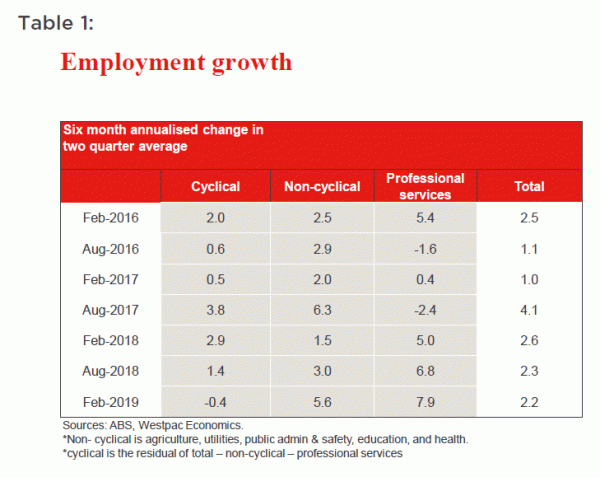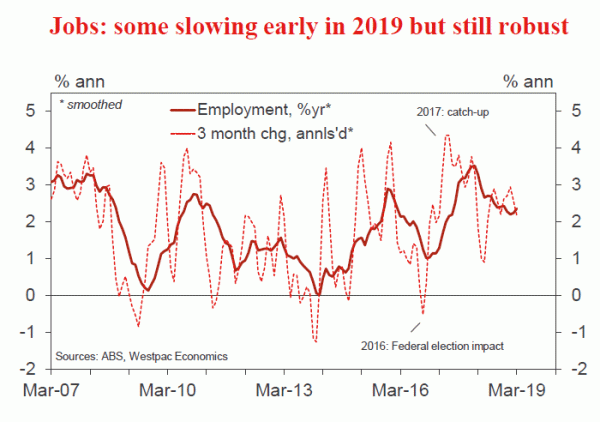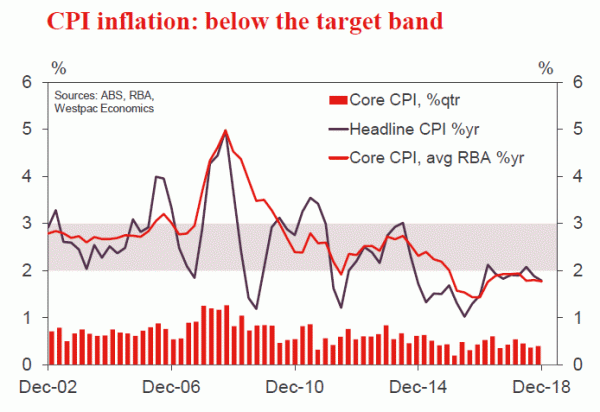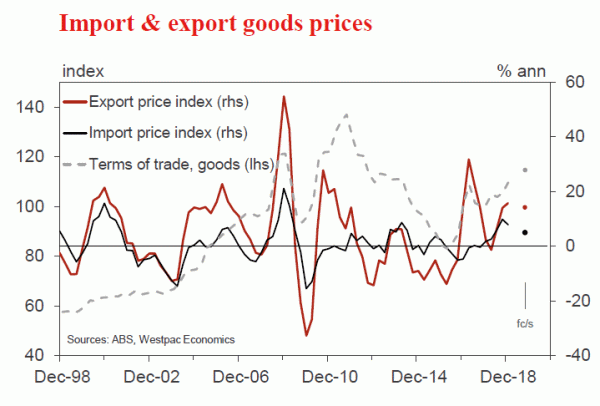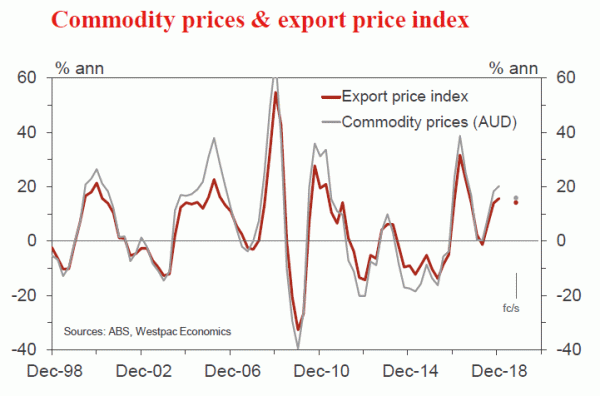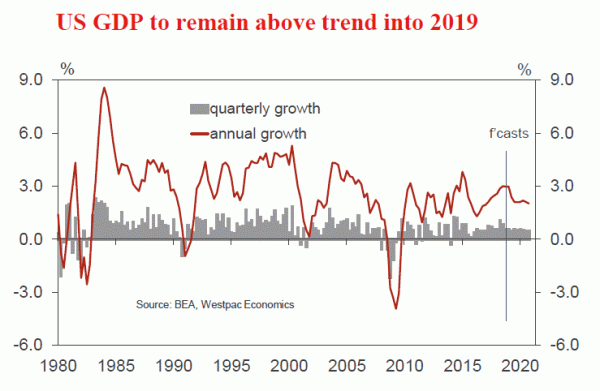Week beginning 22 April 2019
- Some insights into RBA’s employment puzzle. Cyclical jobs are slowing; supporting rate cut.
- Australia: Q1 CPI, trade prices. Easter Monday and ANZAC Day public holiday.
- NZ: trade balance.
- US: Q1 GDP, consumer sentiment.
- Central banks: BoJ and BoC policy decisions.
- Key economic & financial forecasts.
Information contained in this report current as at 17 April 2019.
Some insights into RBA’s employment puzzle Cyclical jobs are slowing; supporting rate cut
The minutes of the April monetary policy meeting of the Reserve Bank Board have provided the clearest signal yet that the Bank would be prepared to cut the cash rate.
Firstly, the final section “Considerations for Monetary Policy” states “a lower level of interest rates could still be expected to support the economy through a depreciation of the exchange rate and via reducing required interest payments on borrowing, freeing up cash for other expenditure”.
The Board even sets out the conditions for a rate cut, “members also discussed the scenario where inflation did not move any higher and unemployment trended up, noting that a decrease in the cash rate would likely be appropriate in these circumstances”.
Recently the latest quarterly breakdown of employment by industry printed for the year to February.
We have considered this industry breakdown to try to find some insights into the RBA’s “tension” between the GDP and Employment Reports.
For a start it is reasonable to separate out the employment data into “cyclical” and “non-cyclical” sectors.
We have looked at “non-cyclical” covering: public administration; education and training; health care; and utilities.
Cyclical sectors are considered to be the other thirteen including: construction; manufacturing; retail and wholesale trade; accommodation; transport; finance; mining; real estate; recreation; and media.
The “non-cyclical “group has increased as a proportion of total employment from 27.9% in February 2008 to 31.9% in February 2019. That 4% increase in share represents 510,000 jobs in today’s workforce.
The cyclical group has fallen as a proportion of the workforce from 64.6% in February 2008 to 59.4% in February 2019.
It is important to note that “public administration” has increased by 18% over the last year but we assess that a considerable part of that increase has been due to reclassification of health and education workers from “private” to “public”.
Because we are including public; education; and health in the noncyclical category the reclassification does not distort the results.
Finally we have one remaining category – “professional services”. This group represents 8.7% of total employment covering: management consulting; computer system design; accounting services; legal services; and engineers. This category represents 8.7% of total employment having increased from 7.4% in February 2008.
Consider Table 1 to assess whether there has been any evidence of the impact of the slowdown in growth in the economy on employment. The table uses the six month annualised growth rate for jobs in the three categories (using a two quarter average to smooth the series).
The following observations are relevant:
- As noted by the RBA, overall momentum in the jobs market has held fairly steady over the last 18 months despite the slowdown in economic growth (2.6% in the six months to February 2018 to 2.2% in the last six months).
- However, momentum in the “cyclical” sectors has slowed markedly from 2.9% in the six months to February 2018 to –0.4% in the six months to February 2019.
- Momentum in the “non-cyclical” sectors has lifted considerably from 1.5% to 5.6% over the same period.
- The professional services sector has been booming.
So the “puzzle” about the labour market is not as opaque as might be expected. Non-cyclical jobs (dominated by government) have been strong and this sector is increasing as a proportion of total employment. Cyclical sectors are slowing markedly and are falling as a proportion of total employment. Given the lags and the cautious outlook for growth, employment in these sectors is likely to continue to slow.
It is not clear whether the “professional services” sector best fits in the cyclical or the non-cyclical categories. Certainly, strong government spending in the infrastructure space is likely to explain a considerable part of the success of this category; the sharp lift in government regulations is also supporting this sector. Furthermore, there is also likely to be a structural element to the success of this sector as companies embrace technology to boost productivity and substitute labour.
Conclusion
The Board of the RBA has nominated the labour market as the key for the policy outlook. We are disappointed that ongoing low inflation and the persistent need to lower growth forecasts seems to be out-weighed by the employment “story”.
Our analysis points to a marked slowdown in jobs growth already being well underway in the cyclical sectors of the economy.
We expect that eventual recognition of these facts will keep the RBA on track for our expected first rate cut in August.
The week that was
This week, the RBA minutes and labour force data were in focus domestically, while China Q1 GDP indicated policy stimulus is starting to take effect.
The April RBA meeting minutes clearly indicated that the Reserve Bank are willing to cut the cash rate if necessary and have set out the conditions that need to be fulfilled for a cut to occur.
In the final section of the minutes, the Board reaffirmed their belief in the stimulatory effect of lower interest rates on the economy via the cash-flow and exchange rate channels. That discounts arguments that suggest there is little benefit from lowering rates further from the already low starting level. In accordance, the Board set out the conditions for a rate cut, “members also discussed the scenario where inflation did not move any higher and unemployment trended up, noting that a decrease in the cash rate would likely be appropriate in these circumstances”.
Given that we have seen conflicting signals from weak GDP growth against strength in the labour market, it would appear that the Board is placing a greater weight on employment from a policy perspective. As we see the labour market as a lagging indicator, we expect slow growth will eventually weigh on employment growth. On this basis, along with inflation remaining low, we continue to forecast cash rate cuts in August and November.
Across the Tasman, NZ Q1 CPI fell slightly short of expectations, up 0.1% against the consensus +0.2%. The surprise came from a weaker read on tradables, down 1.3% in the quarter and 0.4% in annual terms. Indeed, the major driver of the slowing in annual inflation to 1.5% from 1.9% was due to the pullback in fuel. Nevertheless, core inflation remains subdued with the various measures largely in a range of 1.5–1.7%.
After the release, market pricing shifted to a better than even chance of an OCR cut at the May RBNZ Monetary Policy Statement. That concurs with our view for a cut at that meeting. But as RBNZ Governor Adrian Orr has emphasised in recent interviews, the outcome of the May review is far from settled.
Elsewhere, this week was a quiet one in terms of central banks, but China’s Q1 GDP release provided some optimism for the global growth outlook.
Consensus expectation before the release was for a slowing in the annual pace to 6.3% from 6.4% after the authorities opted for a growth target range of 6.0–6.5% for 2019 compared to the previous year’s target of 6.5%.
Instead, growth printed at 6.4% and the March partial data signalled momentum picked up – in particular, industrial production ytd %yr printed at 6.5% against the expected 5.6%. Early signs that Chinese policy stimulus is starting to take effect is encouraging.
Chart of the week: jobs, a robust print; unemployment lifts
Locally, the ABS March labour force release on Thursday provided a timely update.
Employment rose by a robust 25.7k and the February estimate was upgraded a little, to +10.7k from +4.6k.
The unemployment rate rose to 5.0% (5.048%), up from 4.9% (4.94%) as participation lifted from 65.58% to 65.66%. Broadly, the unemployment rate has stalled at around 5.0% since last September, having trended lower from 5.5% at the start of 2018.
There has been some slowing of jobs growth early in 2019, with monthly gains averaging a still robust 24k, moderating from an average of 30k for the December quarter (albeit, broadly in line with the 2018 average of 23k).
There are still three labour force releases before the August RBA meeting – ample time for a clearer change in trend to materialise.
New Zealand: week ahead & data wrap
Should I stay or should I go?
With the Reserve Bank’s May policy decision coming into sight, the next move in the Official Cash Rate remains a close call. We continue to expect a May rate cut. That’s supported by the continued low level of inflation and softness in business sector indicators. However, the longer-term outlook for the economy is looking less worrying than it did a few months ago, especially given the recent news that there won’t be a capital gains tax. That could have an important bearing on the RBNZ’s thinking.
Inflation in New Zealand remains subdued. The March quarter Consumers Price Index revealed that inflation has slowed from 1.9% at the end of 2018 to 1.5% now. That was a little below our own and the RBNZ’s forecast for a 1.6% result. Much of the decline in inflation was due to falls in petrol prices. But even smoothing through the normal quarter-to-quarter volatility, measures of the underlying trend in prices point to inflation of 1.5% to 1.7% – still short of the RBNZ’s 2% long run target. In fact, inflation has essentially remained below 2% for the past seven years.
This ongoing softness in inflation is obviously of concern to the Reserve Bank. Even with the Official Cash Rate at a record low, domestic demand hasn’t been strong enough to generate the pickup in inflation that they’ve been looking for. On top of that, some near-term indicators of business sector activity, including this week’s Performance of Service Index and other recent surveys, are pointing to a cooling in growth through the first half of 2019.
Those concerns, along with nervousness around the global backdrop, saw the Reserve Bank shifting its stance at the time of its March policy decision. In March, the RBNZ noted the next move in the cash rate was more likely to be down. That was a significant dovish lurch from their comments in previous months when they noted that the next move in the OCR could be up or down.
Given the lingering softness in inflation and signs of a cooling in near-term activity, we expect that the RBNZ will cut the cash rate by 25 bps in May. That would take the OCR to a new record low of 1.50%. However, this is a close call. While the near-term picture is soft, the medium-term outlook is starting to look firmer than it did just a few weeks ago.
Looking first at the global front, which was definitely worrying the RBNZ back in March, much of the fear and loathing that rippled through financial markets earlier this year has now eased off. We still expect to see softness in some regions (including Australia). However, downward pressure on interest rates is helping to provide a floor under economic conditions in many economies. And in some of our major trading partners, like China, recent data actually points to a firming in activity.
But while the global backdrop is looking a bit more positive to us, we’re not so certain that the Reserve Bank will have come to the same conclusion. There’s a natural conservativism among central bankers, including those at the RBNZ, meaning that they are more attuned to downside news on the global front than upside developments. The RBNZ is also mindful of the upside risks for the NZ dollar. With that in mind, they might be happier to adopt a ‘wait and see’ approach to the global economy.
On the domestic front, it’s true that a number of business sector indicators are pointing to a near-term cooling in growth. But bubbling below the surface, there are also signs that domestic demand is firming. As we’ve noted before, large increases in Government spending are now being rolled out. We’ve also seen signs that the earlier downshift in net migration and population growth could be less stark than feared. In addition, construction sector indicators are signalling another step higher in building activity this year.
On top of those developments, we’ve also just seen a major change in the stance of fiscal policy. The past week saw the Government cancelling its plan to introduce a capital gains tax. This was a centre-piece policy for the Labour Party (who head the current coalition government). However, this issue has been highly divisive for New Zealand voters, and Labour wasn’t able to convince their coalition partners in the New Zealand First Party to support the policy.
The potential introduction of a capital gains tax has had an important dampening impact on economic confidence in recent months. In our own forecast, we had assumed its introduction would be a significant drag on nationwide house price growth over the next few years (and that was assuming that the policy would be watered down from what was initially proposed). Now, with this policy not proceeding, and with mortgage rates at very low levels, there is a chance of some reacceleration in the housing market over the coming months, along with an associated pickup in household spending.
What the cancellation of capital gains tax means for the Reserve Bank is a little less clear. Their usual practice is not to incorporate policy changes until they have been confirmed. However, potential policy changes can still affect confidence levels and might still shade the RBNZ’s thinking about the outlook.
Putting all this together, the RBNZ will be looking at a soft nearterm outlook for growth and inflation, but the outlook for 2020 won’t look as worrying as it did when they last reviewed the cash rate. Although we expect a cut, these developments could see them staying pat in May.
The final piece of the puzzle will be the March quarter labour market data (due for release on 1 May). If that reveals a lift in the unemployment rate, the RBNZ is likely to feel more comfortable cutting in May. On that front, there has been a pickup in the number of people on jobseeker benefits in the early part of 2019.
If the RBNZ doesn’t cut rates in May, there’s a chance that the door will be closed for the remainder of 2019. Through the second half of this year, we expect that the firming in the global economy will be more obvious. We also expect to see an improvement in the domestic data pulse, particularly in the household sector.
Data Previews
Aus Q1 Consumer Price Index
- Apr 24, Last: 0.5%, WBC f/c: 0.1%
- Mkt f/c: 0.2%, Range: 0.0% to 1.0%
Consumer inflation undershot the RBA’s 2-3% target band in 2018. Headline inflation was 1.8%, including a 0.6% rise in Q4. Core inflation for Q4 printed at 0.4%qtr, 1.8%yr.
Key to this lack of price pressure are: weak wages growth; a housing downturn; sluggish consumer spending; and intense retail competition. While the AUD has weakened the pass through of higher import prices to consumers is limited.
For the March quarter, we expect headline inflation of only 0.1%qtr 1.4%yr. Additional forces at work in the period are: retreating fuel prices, subtracting 0.2ppts (after adding 0.1ppt in Q4); and a seasonally soft quarter (-0.2ppts).
Core inflation is expected to be soft, at 0.3%qtr, moderating to 1.6%yr. This follows a couple of quarters at 0.4%.
For additional detail, see our CPI preview bulletin.
Aus Q1 import price index
- Apr 26, Last: 0.5%, WBC f/c: -0.8%
- Mkt f/c: 0.4%, Range: -1.0% to +0.8%
Prices for imported goods rose by 7.8% in 2018, including a 0.5% lift in Q4. This increase in the cost of imports reflected the impact of the lower Australian dollar and higher global energy prices.
For the March quarter, import prices are forecast to decline by 0.8% (with the risk of a more modest decline).
Key to the expected fall for Q1 is the oil price – which corrected sharply lower after a strong run.
The Australian dollar fell in the quarter – thereby placing upward pressure on the cost of imports. On a TWI basis, the Aussie fell by 2.2% in Q1, with a more modest decline against the US dollar, -0.8%.
Aus Q1 export price index
- Apr 26, Last: 4.4%, WBC f/c: 3.5%
- Mkt f/c: 3.5%, Range: 3.1% to 4.0%
Export prices increased jumped by 15.7% in 2018, including a 4.4% rise in Q4, moving higher on rising commodity prices and a lower Australian dollar.
For Q1, the export price index is forecast to rise by 3.5%.
In the opening quarter of 2019, commodity prices advanced further, up by 4.5% in AUD terms. In addition, the currency fell against the US dollar, placing upward pressure on prices.
The terms of trade for goods, on these estimates, increased by around 4.3% in the March quarter, extending the positive run for Australian national income growth.
As to prices for services, an update will be available with the release of the Balance of Payments on June 4.
US Q1 GDP
- Apr 26, Last 2.2%, WBC f/c: 2.2% annls’d
US data at the turn of the year was disappointingly weak. However, as Q1 has rolled on, momentum has stabilised, and in some instances, begun to firm. As a result, we look for a gain in Q1 a touch above potential at 2.2% annualised.
Domestic final demand is likely to be a little weaker than the headline print, circa 2.0% annualised. Supporting this outcome will be subdued gains for the consumer and business investment, but strength in public demand.
As the year rolls on, the consumer pulse is expected to hold around the current level, but business investment will slow further. The recent decline in residential construction should abate, but this will only partly offset the loss of support from the public sector come Q4.




